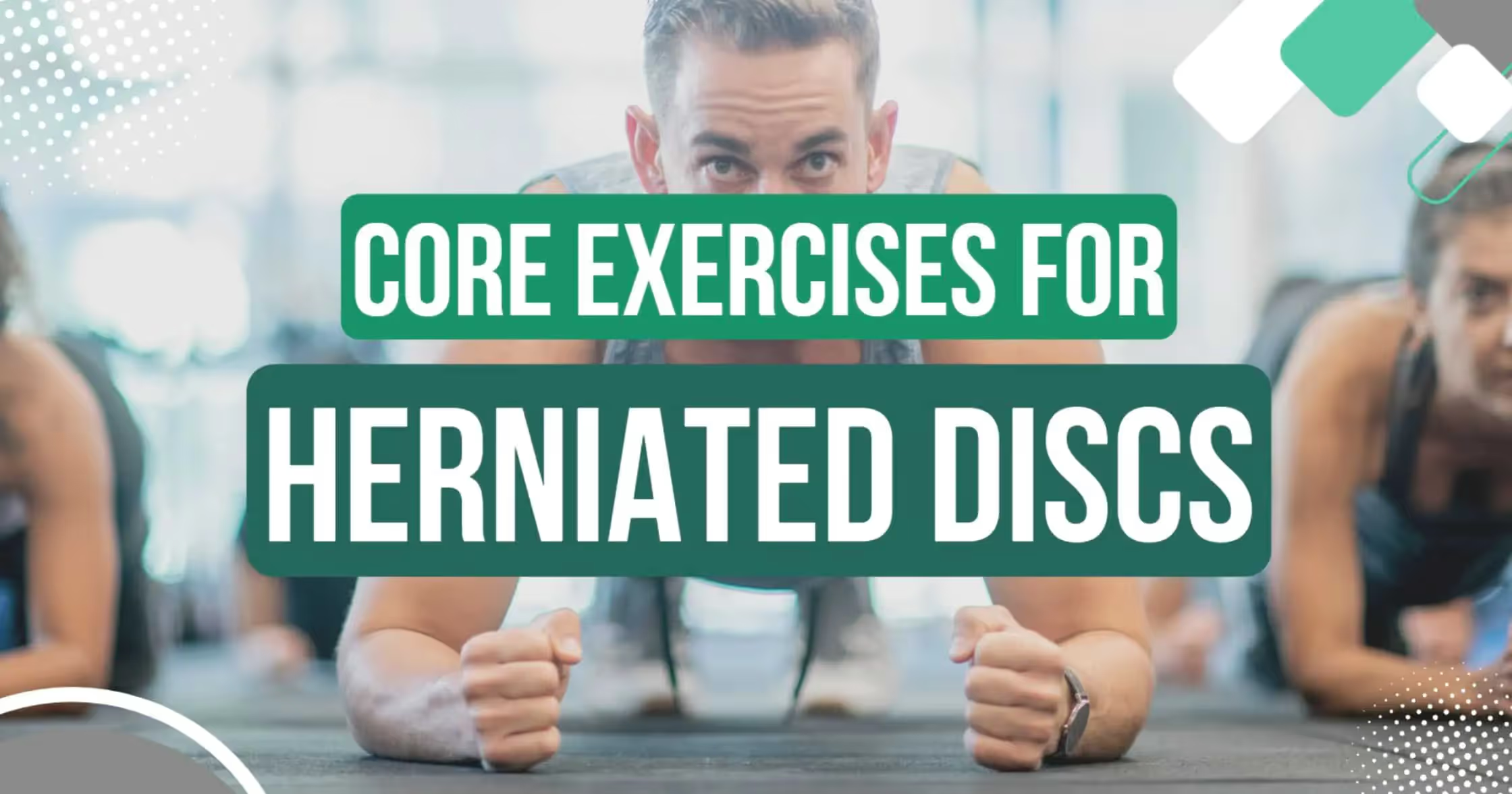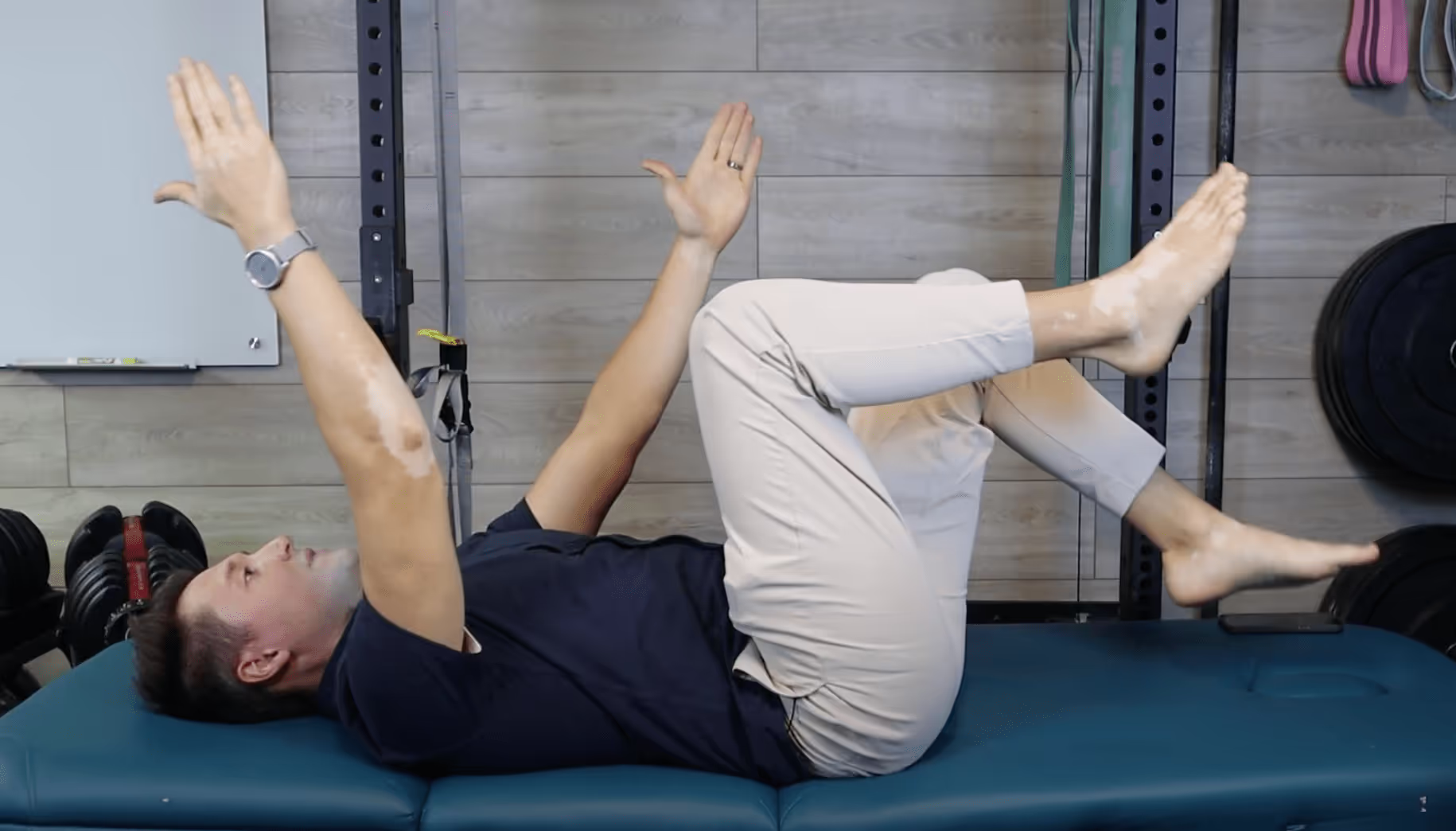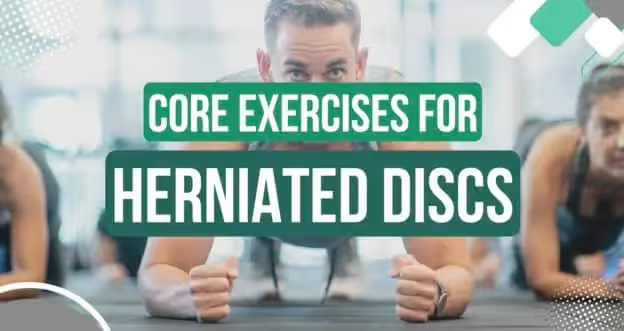
Best Core Exercises for Herniated Discs What To Do and What It Should Feel Like
Best Core Exercises for a Herniated Disc
When dealing with a herniated disc, the goal is to strengthen the core without aggravating the injury. You may experience radiating pain in your legs, and the exercises we select should not exacerbate these symptoms. Based on my experience working with patients, these exercises are practical core strengthening exercises for individuals with a herniated disc. If you aren't sure if you're dealing with Lumbar Spinal Stenosis or Lumbar disc herniation, take the free quiz.
2 Core Strengthening Exercise That Won’t Make Things Worse
Bird-Dog
Clinical Benefits: Strengthens core stability, improves balance, and supports lower back health.
Technique:
- Begin on hands and knees with wrists under shoulders and knees under hips
- Extend one arm forward while reaching the opposite leg straight back
- Hold briefly, keeping spine neutral and core engaged
- Return to start and switch sides
- Perform 2–3 sets of 5–10 reps per side, adjusting based on comfort

Dead Bug
Clinical Benefits: Enhances core strength, stability, and spinal control while reducing stress on the lower back.
Technique:
- Lie on your back with arms extended toward the ceiling and knees bent at 90°
- Slowly lower one arm and the same leg toward the floor
- Keep core engaged and back flat against the surface
- Return to starting position and switch sides
- Perform 2–3 sets of 5–10 reps per side, progressing as tolerated

Exercises to Avoid with Herniated Disc or Disc Bulges
For individuals experiencing pain from disc bulges or herniations, it’s generally recommended to minimize or avoid flexion-based movements. These positions bend the spine forward or brining your knees close to your chest, which can increase pressure on the discs and aggravate symptoms.
Specific Stretches to Avoid
- Knees-to-chest stretch
- Back flexion stretches (such as Child’s Pose or Prayer Stretch)
Best Core Strengthening Exercises for a Bulging Disc
For those with a bulging disc, core exercises should focus on stability and lumbar extension. Think standing and waking. Here are some that are great at strengthening your core.
Bridge
Clinical Benefits: Strengthens glutes and core and supports lumbar extension.
Technique:
- Lie on your back with knees bent and feet flat on the floor
- Press through your heels to lift hips toward the ceiling
- Squeeze glutes and engage core at the top
- Hold briefly, then lower hips back down with control
- Perform 2–3 sets of 8–12 reps, progressing as tolerated

Swiss Ball Plank
Clinical Benefits: Builds core endurance, improves postural stability, and supports spinal health.
If you don't have one, you can find one here!
Technique:
- Begin in a forearm position on the exercise ball
- Keep body in a straight line and tuck your chin
- Engage core muscles and avoid letting hips sag or lift too high
- Hold for 10–30 seconds to start
- Progress to 2–3 sets of 30–60 seconds as tolerated

Mini-Squat
Clinical Benefits: Strengthens quadriceps and glutes, promotes knee stability, and supports daily functional movement.
Technique:
- Stand with feet about shoulder-width apart
- Lower into a squat as if sitting back into a chair, bending knees 30–45°
- Keep chest upright and weight in heels
- Option: Add a single-arm bicep curl while squatting for increased challenge
- Perform 2–3 sets of 8–12 reps

This $7 guide provides a full set of core stretches and exercises designed for sciatica.
What is the Difference Between a Herniated Disc and a Bulging Disc?
As a physical therapist who treats a significant number of patients with back pain and spinal conditions, the topic of disc bulges and disc herniations often comes up. There are substantial differences between these two terms.
Understanding the difference between the two terms can help temper expectations and guide rehabilitation.
A bulging disc occurs when a disc, which acts as a cushion between the vertebrae, starts to protrude outward, most commonly posteriorly or backwards, but maintains its overall structure. This bulge can press on nearby nerves, causing pain, tingling, or numbness in the limbs. At other times, you may have a bulge with no symptoms. However, unlike a herniation, the inner part of the disc remains intact within its outer layer.
A herniated disc, on the other hand, is when the inner gel-like substance of the disc (nucleus pulposus) pushes out through a tear in the outer layer (annulus fibrosus). This rupture can exert more pressure on the nerves and surrounding tissues, often leading to more intense pain and symptoms, such as muscle weakness or loss of reflexes.
Herniated discs can often be confused with muscle strains as well. For help diagnosing between those, read our article "Herniated Discs vs. Muscle Strains" here.
.avif)
We Can Reverse a Disc Bulge of Herniation
There is strong evidence that disc bulges and herniations physiologically heal over time. Yes, disc bulges and herniations do improve over time and are not permanent changes in our anatomy. I have seen not only symptoms improve but images such as MRI improve.
Disc bulges and even severe disc herniations can and do change in a positive manner, both naturally with time and with the proper exercises environment (proper rest and recovery, rehabilitation program with a rehab professional, etc).
What I find most fascinating, and encouraging, is that the worse the herniation, the more likely there is to be spontaneous regression of that herniation.
That’s right, and counter to intuition, the worse the injury, the more likely there is to be spontaneous regression of that disc injury. The theory is that the worse the herniation, the more substantial and more immediate the inflammatory response. In this situation, the inflammatory response is what signals to the body where to begin healing.
What is also very important to know about disc bulges and herniations is that imaging (such as MRI) during the recovery process typically does not correlate with symptoms, and I mean that in a positive way! MRIs can make your recovery pathway more cloudy and prolong recovery. In general, I tell my patients to stay away from MRIs!
For example, many times I will have a patient who has completed 2-3 months of rehab and will report significantly reduced pain and symptoms despite follow-up imaging revealing that the bulge or herniation has only slightly improved in terms of its appearance.
The takeaway is your symptoms will often improve much more rapidly than your images.
Diagnostic images only show structures, not the complex properties of pain. Do not be distraught or disappointed if you feel better even though your pictures aren’t perfect.
Degenerative Disc Disease (DDD) - Core Strengthening Summary
DDD is an age-related spinal change, often symptom-free and only found through imaging. Unlike herniated discs, it’s less likely to cause leg pain or numbness. Core strengthening is key, and most exercises used for herniated or bulging discs are safe. Limit flexion at first, though some people benefit from it. Movement restrictions should be temporary—spines need motion in all directions for long-term health. With the right program, DDD is very manageable.
Summary
This blog shares safe core exercises for herniated and bulging discs, including Bird-Dog, Dead Bug, Bridge, Swiss Ball Plank, and Mini-Squats. It covers which moves to avoid, differences between disc conditions, and why core strength is key to recovery. With the right approach, disc issues can heal, symptoms improve, and long-term spinal health is possible.
References
Best Core Exercises for a Herniated Disc
When dealing with a herniated disc, the goal is to strengthen the core without aggravating the injury. You may experience radiating pain in your legs, and the exercises we select should not exacerbate these symptoms. Based on my experience working with patients, these exercises are practical core strengthening exercises for individuals with a herniated disc. If you aren't sure if you're dealing with Lumbar Spinal Stenosis or Lumbar disc herniation, take the free quiz.
2 Core Strengthening Exercise That Won’t Make Things Worse
Bird-Dog
Clinical Benefits: Strengthens core stability, improves balance, and supports lower back health.
Technique:
- Begin on hands and knees with wrists under shoulders and knees under hips
- Extend one arm forward while reaching the opposite leg straight back
- Hold briefly, keeping spine neutral and core engaged
- Return to start and switch sides
- Perform 2–3 sets of 5–10 reps per side, adjusting based on comfort

Dead Bug
Clinical Benefits: Enhances core strength, stability, and spinal control while reducing stress on the lower back.
Technique:
- Lie on your back with arms extended toward the ceiling and knees bent at 90°
- Slowly lower one arm and the same leg toward the floor
- Keep core engaged and back flat against the surface
- Return to starting position and switch sides
- Perform 2–3 sets of 5–10 reps per side, progressing as tolerated

Exercises to Avoid with Herniated Disc or Disc Bulges
For individuals experiencing pain from disc bulges or herniations, it’s generally recommended to minimize or avoid flexion-based movements. These positions bend the spine forward or brining your knees close to your chest, which can increase pressure on the discs and aggravate symptoms.
Specific Stretches to Avoid
- Knees-to-chest stretch
- Back flexion stretches (such as Child’s Pose or Prayer Stretch)
Best Core Strengthening Exercises for a Bulging Disc
For those with a bulging disc, core exercises should focus on stability and lumbar extension. Think standing and waking. Here are some that are great at strengthening your core.
Bridge
Clinical Benefits: Strengthens glutes and core and supports lumbar extension.
Technique:
- Lie on your back with knees bent and feet flat on the floor
- Press through your heels to lift hips toward the ceiling
- Squeeze glutes and engage core at the top
- Hold briefly, then lower hips back down with control
- Perform 2–3 sets of 8–12 reps, progressing as tolerated

Swiss Ball Plank
Clinical Benefits: Builds core endurance, improves postural stability, and supports spinal health.
If you don't have one, you can find one here!
Technique:
- Begin in a forearm position on the exercise ball
- Keep body in a straight line and tuck your chin
- Engage core muscles and avoid letting hips sag or lift too high
- Hold for 10–30 seconds to start
- Progress to 2–3 sets of 30–60 seconds as tolerated

Mini-Squat
Clinical Benefits: Strengthens quadriceps and glutes, promotes knee stability, and supports daily functional movement.
Technique:
- Stand with feet about shoulder-width apart
- Lower into a squat as if sitting back into a chair, bending knees 30–45°
- Keep chest upright and weight in heels
- Option: Add a single-arm bicep curl while squatting for increased challenge
- Perform 2–3 sets of 8–12 reps

This $7 guide provides a full set of core stretches and exercises designed for sciatica.
What is the Difference Between a Herniated Disc and a Bulging Disc?
As a physical therapist who treats a significant number of patients with back pain and spinal conditions, the topic of disc bulges and disc herniations often comes up. There are substantial differences between these two terms.
Understanding the difference between the two terms can help temper expectations and guide rehabilitation.
A bulging disc occurs when a disc, which acts as a cushion between the vertebrae, starts to protrude outward, most commonly posteriorly or backwards, but maintains its overall structure. This bulge can press on nearby nerves, causing pain, tingling, or numbness in the limbs. At other times, you may have a bulge with no symptoms. However, unlike a herniation, the inner part of the disc remains intact within its outer layer.
A herniated disc, on the other hand, is when the inner gel-like substance of the disc (nucleus pulposus) pushes out through a tear in the outer layer (annulus fibrosus). This rupture can exert more pressure on the nerves and surrounding tissues, often leading to more intense pain and symptoms, such as muscle weakness or loss of reflexes.
Herniated discs can often be confused with muscle strains as well. For help diagnosing between those, read our article "Herniated Discs vs. Muscle Strains" here.
.avif)
We Can Reverse a Disc Bulge of Herniation
There is strong evidence that disc bulges and herniations physiologically heal over time. Yes, disc bulges and herniations do improve over time and are not permanent changes in our anatomy. I have seen not only symptoms improve but images such as MRI improve.
Disc bulges and even severe disc herniations can and do change in a positive manner, both naturally with time and with the proper exercises environment (proper rest and recovery, rehabilitation program with a rehab professional, etc).
What I find most fascinating, and encouraging, is that the worse the herniation, the more likely there is to be spontaneous regression of that herniation.
That’s right, and counter to intuition, the worse the injury, the more likely there is to be spontaneous regression of that disc injury. The theory is that the worse the herniation, the more substantial and more immediate the inflammatory response. In this situation, the inflammatory response is what signals to the body where to begin healing.
What is also very important to know about disc bulges and herniations is that imaging (such as MRI) during the recovery process typically does not correlate with symptoms, and I mean that in a positive way! MRIs can make your recovery pathway more cloudy and prolong recovery. In general, I tell my patients to stay away from MRIs!
For example, many times I will have a patient who has completed 2-3 months of rehab and will report significantly reduced pain and symptoms despite follow-up imaging revealing that the bulge or herniation has only slightly improved in terms of its appearance.
The takeaway is your symptoms will often improve much more rapidly than your images.
Diagnostic images only show structures, not the complex properties of pain. Do not be distraught or disappointed if you feel better even though your pictures aren’t perfect.
Degenerative Disc Disease (DDD) - Core Strengthening Summary
DDD is an age-related spinal change, often symptom-free and only found through imaging. Unlike herniated discs, it’s less likely to cause leg pain or numbness. Core strengthening is key, and most exercises used for herniated or bulging discs are safe. Limit flexion at first, though some people benefit from it. Movement restrictions should be temporary—spines need motion in all directions for long-term health. With the right program, DDD is very manageable.
Summary
This blog shares safe core exercises for herniated and bulging discs, including Bird-Dog, Dead Bug, Bridge, Swiss Ball Plank, and Mini-Squats. It covers which moves to avoid, differences between disc conditions, and why core strength is key to recovery. With the right approach, disc issues can heal, symptoms improve, and long-term spinal health is possible.




%20Blog%20thumbnails%204.avif)
